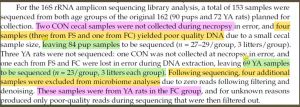Discuss Gut Microbiome Alterations following Postnatal Iron Supplementation Depend on Iron Form and Persist into Adulthood
RAT PUPS Rat pup sample size was stated as (n = 27-29/group, 3 litters/group). (Source: Text 2.8 Statistical Analysis, 2nd Paragraph) Alpha-diversity measures in rat pups at PD 15 can be found in Supplementary figure S2. Significant differences in each alpha-diversity metric due to treatment and among treatment groups were detected at each depth by Kruskal–Wallis test, and Dunn’s post-hoc test, respectively.
YOUNG ADULT(YA) RATS Young Adult(YA) rat sample size was stated as (n=23/group, 3 litters/group). A total number of 69 YA samples to be sequenced, but after which four additional samples were excluded from microbiome analyses due to zero reads following filtering and denoising. These samples were from YA rats in the FC group, and for unknown reasons produced only poor-quality reads during sequencing that were then filtered out. (Source: Text 2.8 Statistical Analysis, 2nd Paragraph) Alpha diversity measures in YA rats can be found in Supplementary figure S5.
===Sample Size=== --Joan Chuks (talk) 13:28, 17 April 2024 (UTC)
we can infer the sample size from the attached text in the study
Pre-weaned rat pups So initially, For each treatment group (control, ferrous sulfate, and ferrous bis-glycinate chelate), they started with 3 litters and culled each to 10 pups, so they would have a total of: 3 litters/group * 10 pups/litter = 30 pups/group Therefore, there would be a total of 30 pups in each of the initial treatment groups.
For 3 groups total = 90 (Pre-weaned pups) Vehicle control-supplemented (CON) pups = 30; Ferrous sulfate (FS) treated pups (PD 15) = 30; Ferrous bis-glycinate chelate (FC) treated pups (PD 15) = 30;
During analysis 6 were excluded and they were left with total of 84. Among the 6: 2 were CON cecal samples which were not collected during necropsy in error, and 4 samples (three from FS and one from FC) yielded poor quality DNA.... so that means they now have these: Vehicle control-supplemented (CON) pups = 30 - 2 =28; Ferrous sulfate (FS) treated pups (PD 15) = 30 - 3 =27; Ferrous bis-glycinate chelate (FC) treated pups (PD 15) = 30 -1 =29;
For the Young adult rats: here's what I think it is based on the info in the attached text from the study. Ferrous sulfate (FS) treated young Adult = 23; Ferrous bis-glycinate chelate (FC) treated young Adult (YA) rats =19 (23 minus the 4 additional ones that were excluded); Vehicle control-supplemented (CON) young Adult (YA) rat =23;
So, Here's our sample size: (pre-weaned pups (27-29) Ferrous sulfate (FS) treated pups (PD 15) = 27; Ferrous bis-glycinate chelate (FC) treated pups (PD 15) =29; Vehicle control-supplemented (CON) pups = 28;
For the Young adults (YA): Ferrous sulfate (FS) treated young Adult = 23, Ferrous bis-glycinate chelate (FC) treated young Adult (YA) rats =19; Vehicle control-supplemented (CON) young Adult (YA) rat =23--Joan Chuks (talk) 13:28, 17 April 2024 (UTC)

